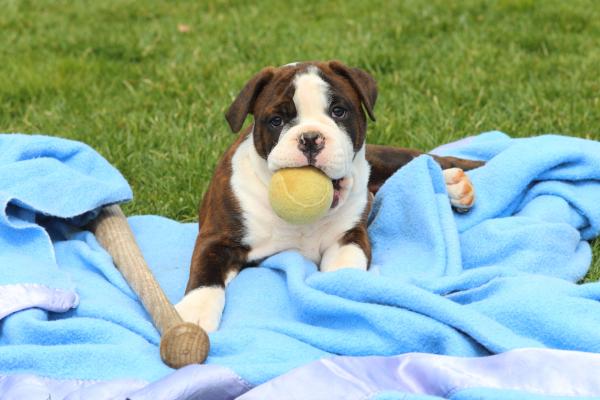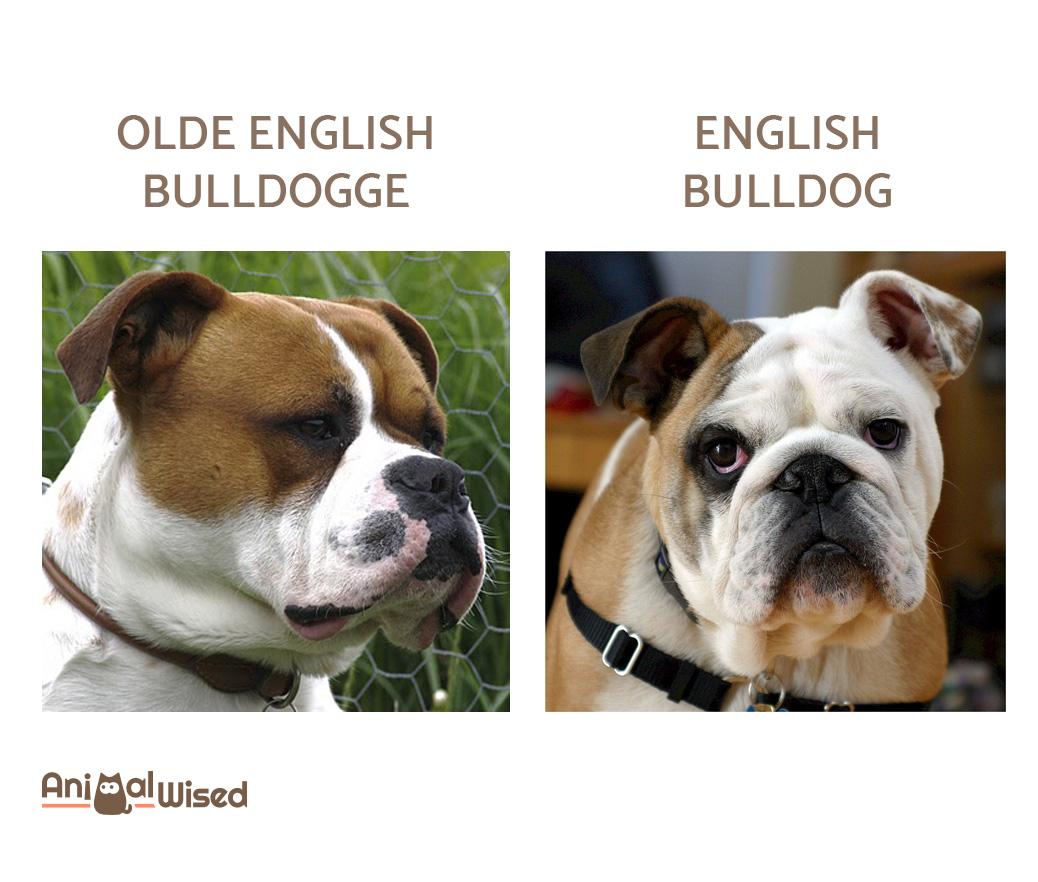What is an Olde English Bulldogge?



See files for Dogs
Olde English Bulldogge, Old English Bulldog and English Bulldog are terms that seem to refer to the same dog breed. However, these names refer to three related, but separate dogs. As we'll explain below, the Olde English Bulldogge is a breed created in the 1970s in the United States, which tried to re-create the healthier version of the already extinct Old English Bulldog by crossing several breeds. Among them was the more popular English Bulldog.
Confused? Don't worry! At AnimalWised we'll untangle the situation and make sure you know what is an Olde English Bulldogge and learn to tell the difference between an Old English Bulldog and an English Bulldog without trouble.
The history of the Olde English Bulldogge
To know what is an Olde English Bulldogge, we first need to look at their origins. In doing so, it will be much easier to tell the difference between their close counterparts the Old English Bulldog and the English Bulldog.
The Olde English Bulldogge was created by American breeders in the 1970s in order to re-create the original Old English Bulldog. These were the English dogs used for bull baiting from the 1100s until the 19th century, when this sport was declared illegal. According to David Leavitt, the creator of the Olde English Bulldogge, he was looking to create a lineage of dogs that had similar characteristics to those Old English Bulldogs of the 1800s, also known as ‘Regency Period Bull Baiters’
With this in mind, in 1971 Leavitt began his scheme to achieve a purebred dog that matched the "Regency Period" Bulldogs. He did so by crossing breeds with the following genetic lineage:
- ½ English Bulldog
- ⅙ American Bulldog
- ⅙ American Pit bull Terrier
- ⅙ Bull Mastiff
He did so to achieve a dog which lessened some of the traits which had become issues for the current English Bulldogs. Namely, their problematic bone structure, predisposition to genetic disease and issues with aggression.
The Olde English Bulldgge Association, worked to register and keep the standards of the breed. However, in 2005 David Leavitt officially broke ties with the Olde English Bulldogge Association and the name of the Olde English Bulldogge, stating that the breed no longer had the appearnace of the Regency Old English Bulldog. He decided to change the current dog breed's name to Leavitt Bulldog.
Many breeders were against changing the Olde English Bulldogge's name. In 2014, both the Leavitt Bulldog and the Olde English Bulldogge were accepted in the United Kennel Club[1]. However, they were inducted under the same requirements and characteristics, meaning that there is no formal distinctions between the two.
What is the difference between English Bulldog and Olde English Bulldogge?
When we compare the English Bulldog vs. the Old English Bulldog, we need to keep in mind the latter was created to overcome some of the issues of the former. The Olde English Bulldogge is described by the UKC as a muscular dog of medium size that has great strength and is very agile. Their body is proportionate and is not known to have breathing problems. Their character is friendly, alert and confident.
On the other hand, the English Bulldog is not as proportionate, as it has wide, heavy set shoulders and becomes lighter as their body approaches their hindquarters. Their height and weight also differs from the latter, as an English Bulldog weighs an average of 40-50 lbs, whereas the Olde English Buldogge is heavier, weighing an average 60-80 lbs. Moreover the English Bulldog's height is generally shorter, as they tend to have stockier and sturdier legs.
The UKC also disapproves of wrinkles in the Olde English Bulldog. Conversely, it is one of the most common traits in the English Bulldog breed standard. Another characteristic that differentiates the two Bulldog breeds' face is that the Olde English Bulldog has a longer muzzle with wider nostrils. English Bulldogs are known as being brachycephalic dogs which contributes to their health issues, particularly respiratory problems.
As mentioned, the Olde English Bulldog was bred in order to eliminate the issues that arose by breeding the English Bulldog for years according to aesthetic standards, which created many health issues in the purebred English Bulldog breed. Thus, some of the features of the Olde English Bulldog prevent them from suffering from breathing issues and heart problems. However, the Olde also has many health issues that also come from inbreeding such as hip dysplasia.

Difference between the Old English Bulldog and the English Bulldog
One of the most complicated factors is that there is another breed known as the Old English Bulldog. This is the now extinct bulldog breed which led to the current incarnation of the English Bulldog. What makes matters more confusing is the fact that the spelling of Olde English Bulldogge is a type of archaic spelling, implying it is older. In fact, it is the newer version of the breed they tried to replicate. This older version has the more modern spelling of Old English Bulldog.
As mentioned, the Old English Bulldog was used as a fighting dog and took part in bull-baiting. The prominence of their lower jaw made their grip even stronger, making them a desired choice for blood sports.
It is hard to know the temperament of the Old English Bulldog with their human guardians. They were mainly used as fighting dogs and they were known to have small brains. They were fierce in the fighting pit and very effective. In 1835, the Cruelty to Animals Act was approved in the British parliament, thus making dog fighting illegal.
Despite this new law, illegal dog fighting continued, but breeders determined that crossing the Regency era Old English Bulldog and the Old English Terrier resulted in a much more powerful dog that, with time created the breeds we know today as the Bull Terrier and the American Pit Bull Terrier depending on their lineage. Thus, the lack of interest in preserving the Old English Bulldog bloodline made them become extinct.
How to Train an Olde English Bulldogge
Now that you know exactly what is an Olde English Bulldogge, let's take a look at a few training techniques that will suit their affable character so they can live a happy and fulfilled life if you are thinking to adopt one.
As mentioned above, the Olde Englsih Bulldogge has a more docile character than the English Bulldog, which is why they will be slightly easier to train, provided you start their education at a young age. Owners should start socialization as soon as they reach three months of age. Olde English Bulldogges are slightly wary of strangers and have a strong bond with their families. You will need to work on their relationships with other humans that are not directly linked to direct family in order to raise a friendly dog.
This dog breed is highly intelligent and somewhat more independent than others, this is why you should be very consistent when teaching obedience, always spending around 15-30 minutes a day practicing their obedience skills. Moreover, they are also highly athletic dogs, which is why they should enjoy longer and more frequent walks than that of the English Bulldog. It is recommendable to give them light exercise, so 2 to 3 half hour walks will be enough.
Due to their sociable temperament, they will enjoy waking in groups. If you have other dogs in the neighborhood, it will be a good idea to join them. Take advantage of walks to practice a few tricks and games, which will highly benefit their mental well-being. Once the dog has mastered their basic training, they will enjoy learning agility with their owners due to their athletic structure. Take into account that this breed is pretty sensitive to extreme temperatures, which is why you should care for them and avoid taking them out in very cold or warm weather conditions.

What to feed an Olde English Bulldogge
Many dog owners will ask themselves what they should feed an Olde English Bulldogge. The scarce information on this dog breed's diet and the confusion with the English Bulldog may leave dog owners pretty perplex.
When they are puppies, weaned Olde English Bulldogges should have four bowls full of specific puppy food until they are 12 weeks old. Then, they will have their feeds reduced to 3 up to 6 months and then to 2 daily feeds once they are one year old, always giving them full-grown dry dog feed.
You can combine this with boiled egg and fruits suitable for dogs for extra protein and vitamins on counted occasions, but you should be weary of giving them cooked bones as they can create tooth and bone issues easily.
If you want to read similar articles to What is an Olde English Bulldogge?, we recommend you visit our What you need to know category.







